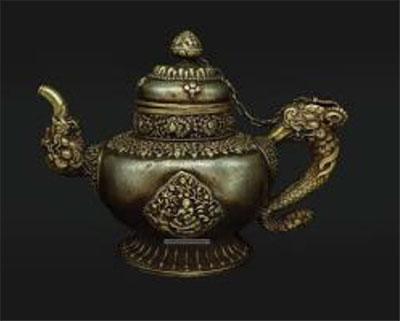
Ladakh metalwork is a centuries-old tradition known for producing beautiful and functional goods. Copper and silver are the major metals used by Ladakhi artists for creating a wide range of goods. Ladakh has a great effect on Tibetan Buddhism, as seen by the metalwork, which often includes religious themes and symbols. Butter lamps (choe-me), incense burners, and ritual daggers (phurba) are all well-crafted and vital in Buddhist practices. Traditional instruments like cymbals and horns are created using Ladakhi metalwork.
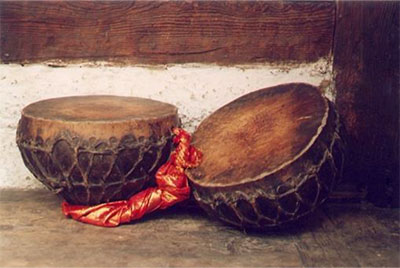
Ladakh's musical instruments reflect Buddhist and Tibetan influences and are used on many religious and cultural occasions. DAMAN is a copper instrument shaped like a large bowl with copper sides wrapped in cow leather.
SURNA is made of willow and resembles a shehnai. The Surna pipe's top has seven holes in the front and two at the back, decorated with coral and turquoise stone. The PIWANG, a string instrument similar to the violin, is made of willow or apricot wood. Piwang is highly popular among the nomadic people who live with their herds on the high Changthang plateau and is supported by their traditional dance, Jabro.
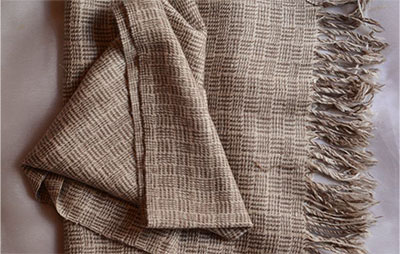
Ladakh's Pashmina shawls are famous for their sumptuous quality, warmth, and excellent workmanship. They are made from the delicate underfurs of Changthangi goats, a rare breed found in the heights of eastern Ladakh's Changthang area, which borders the Tibetan Plateau. Because of the severe Ladakhi environment, Changthangi goats develop a thicker winter coat with an extraordinarily soft, downy under-fleece called Pashm, which is used to make the shawls. Ladakhi pashmina shawls are traditionally stained with natural plant and mineral dyes, giving a rich and earthy colour pallet. The shawls are admired for their basic beauty, with twill weaving that forms delicate geometric patterns on the cloth.
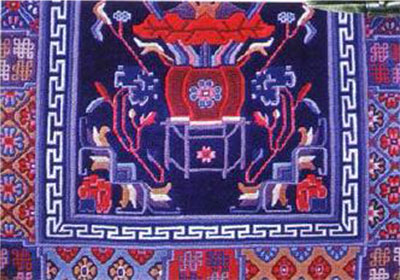
There are two kinds of carpets usually woven in Ladakh: Khabdan carpets, the most popular kind of Ladakhi carpets, are pile carpets. They are known for their durability and warmth as they are woven on vertical looms using a loop knot method. Tsugden carpets are flat, kilim-style carpets that Ladakhi nomads have historically used for beds and floor coverings. They are woven on portable backstrap looms using hand-spun sheep or yak wool and are distinguished by their brilliant colours and geometric designs. Ladakhi carpets have a gorgeous and distinct colour palette made from natural dyes obtained from plants and minerals.
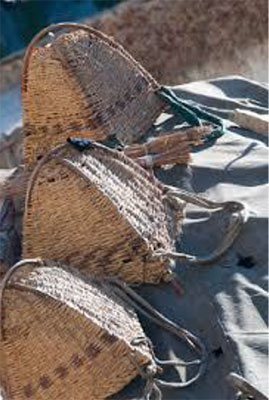
Basketry is a major art craft in Ladakh, passed down through generations to make practical and attractive products for daily use. The most popular sort of Ladakhi basket is the Tsepo, a huge, backpack-style basket that has historically been used to transport a range of objects, including firewood, vegetables, dung, and even newborns. Ladakhi baskets are made mostly from chipkiang grass, a natural plant that grows abundantly across the area. Chipkiang grass is tough and robust, making it suitable for basket weaving. Ladakhi basket makers manufacture Tseptos and other baskets using a variety of weaving methods.
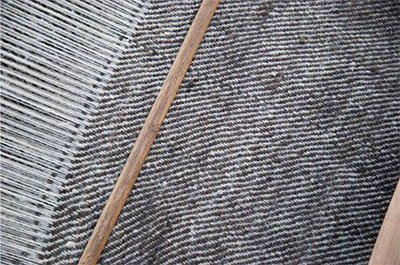
Snambu is a traditional woollen fabric woven in Ladakh known for its warmth, durability, and beautiful simplicity. Wool is made from the fleece of local sheep, generally undeveloped breeds suited to the harsh Ladakh environment. Snambu's twill weave gives the cloth a diagonal ribbed pattern that provides strength. Snambu is a fundamental cloth used for making traditional Ladakhi garments like the goncha (long robe) for ladies and the choga (gown) for men. The thick, closely woven cloth offers great insulation during the chilly Ladakh winters.
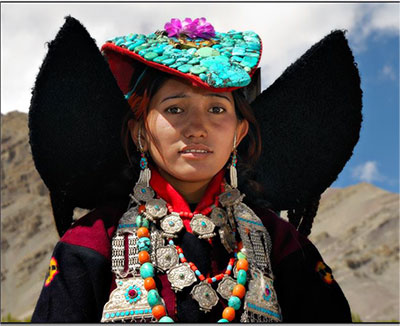
The perak is a traditional headgear worn by Buddhist women in Ladakh during wedding rituals. The perak is a tall, flat-crowned hat originally made of brocade. Brocade is a fabric with elevated motifs made from additional weft threads. The perak is embroidered with bright floral or geometric designs and Buddhist motifs. The perak also symbolises the bride's riches and social standing in society. Traditionally, the number of rows of turquoise gemstones on the perak indicated the bride's family's social status. The perak is handed down from mother to daughter, becoming a treasured artefact that expresses family history and cultural customs.
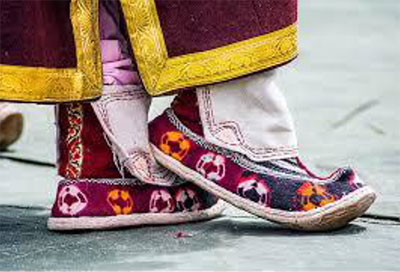
Paboo is Ladakh's traditional footwear, created particularly for severe winters and high-altitude terrain. Paboos are knee-length boots meant to keep feet warm and protected from Ladakh's cold weather and snow. The base of the Paboo usually consists of hessian cloth or other strong fabric for structure. The inner is lined with wool felt or coarse yak hair to provide warmth and insulation. The soles are made of yak or buffalo leather for endurance on tough terrain. The boot's sides are made of coarse hair spun into thin rope and tied together, providing flexibility and extra insulation.
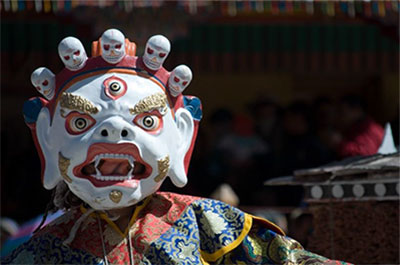
The Hemis Festival in Ladakh is renowned for its colourful masked dances monks perform. These masks are more than simply colourful and physically appealing; they also have significant cultural and religious meanings. The mask's foundation is often made of paper mache, which creates a lightweight and flexible basis. Clay moulds are used to sculpt the basic form of the mask before adding the paper mache. Other natural materials like fabric and dough are also used for special features. The masks depict various Buddhist mythological characters, including wrathful deities, protective figures, and historical individuals like Guru Padmasambhava (founder of Tibetan Buddhism in Ladakh).